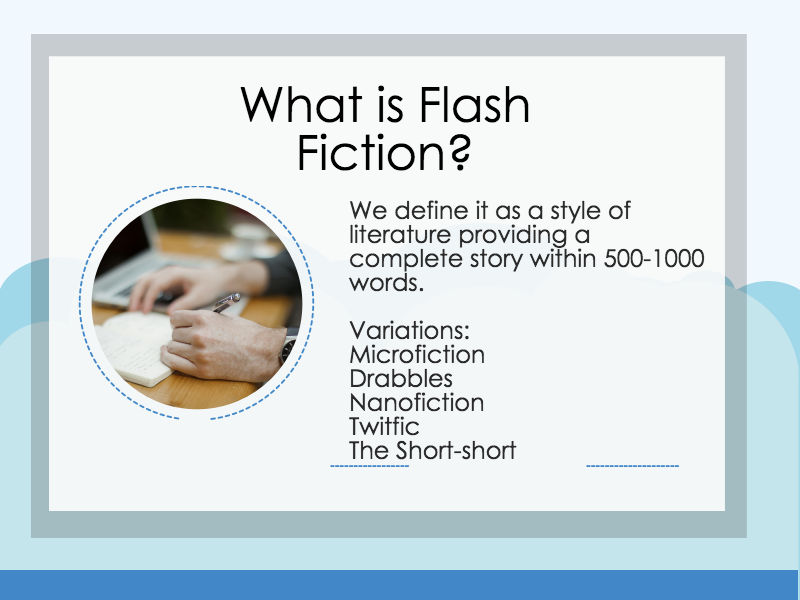
What exactly IS flash fiction?
That’s an excellent question. And depending on who you ask, you’ll get a very different answer.

For Flash Fiction Online purposes, we consider flash fiction to be a very short story with a complete character arc written within the confines of 500-1000 words. We know that’s asking a lot (and that’s part of why we’re putting together this series) but for a skillful writer, it can be done.
Flash has a few defining characteristics.
A VERY SMALL WORD COUNT
How many words you can squeeze into that tiny story depends on the publication you’re submitting to. For our purposes, we have a tight cutoff limit of 500-1000 words.
If you think that’s a hard and fast limit, visit the folks over at [100wordstory]. They’re not messing around. It’s 100 words on the nose, or you’re out of there faster than I can hit the Popcorn button on my microwave.
Or based on the infamous “baby shoes,” try out a Six-word story at Narrative.
NPR hosts a three-minute fiction contest requiring entries of 600 words or less.
Cease, Cows will give you up to 1500 words.
Finally, if you’d like a challenge, aim for 100 characters and compose a “twabble” aka a Tweeted drabble. You can submit your 100-word stories as a drabble along with your twabble to Drabblecast.
But if you’d like to submit to us, you’ll have to either flesh out or trim down that story to slide nicely between our 500-1000 word guidelines.
A COMPLETE STORY
Now, if you thought that a small word count meant a smaller narrative bar to climb, I’m going to disillusion you right now. Flash fiction is still a story, and every good story has a beginning, middle, and end, even if that format is experimental.
But wait, you’re saying, what about vignettes or slice-of-life stories?
Well, that’s where it gets a bit murky.
A vignette, according to the Oxford Dictionary, is “a brief evocative description, account, or episode.” That’s very close to being a story but not quite.
And Wikipedia defines slice-of-life as “a storytelling technique that presents a seemingly arbitrary sample of a character’s life, which often lacks a coherent plot, conflict, or ending.” Again, almost a story, but not quite.
Both vignettes and slice-of-life stories lend themselves very well to the brief format of flash fiction. And don’t get me wrong–I enjoy both of these literary formats quite a bit. They’re just not what we’re talking about when it comes to defining flash fiction.
So back to that pesky beginning/middle/end part.
We’ll talk more about how to effectively fit all of that into your story later. For now, suffice it to know that all three elements need to be there.
It takes a tremendous amount of skill to pull this off well. If anyone ever tells you that flash fiction is easy because it’s so short, send them on over to our slushpile and see how they fare. It’s the opposite. The shorter the story, the harder it is to tell it well.
CONFLICT
A well-told narrative always has conflict. We’ll get more into conflict and struggle in later posts, but I want to go ahead and brand it into your frontal lobes that YOUR STORY MUST HAVE CONFLICT.
Conflict does not (necessarily) mean swords or bombs or aliens.
Conflict can be small and internal.
But it must be present.
CHARACTERS
This seems like a gimme but I’m going to put it out there anyway. You gotta have some characters, okay?
I know someone is already scrambling off to prove they can write a story without any characters and that story will inevitably land in my slushpile and then I’ll have to eat crow because NOW THERE IS A STORY WITH NO CHARACTERS.
But please don’t do that.
Or if you can think of a story without characters, leave it in the comments.
Because what would Lord of the Rings be without Frodo and Samwise and Gandalf? Or Deadpool
without, well, Deadpool? Even the infamous “baby shoes” involves characters even though they’re unnamed and off-stage–they’re defined by their absence.
And since we’re talking about characters…
A CHARACTER ARC
This is a combination of your characters encountering conflict. And what happens when we struggle with a decision, a foe, the world-at-large?
We change.
And that, my friends, is the point of a story.
To show the reader the change in a character as they grapple with conflicts.
Squeeze it into 500-1000 words and now you’re writing flash fiction.
For more flash fiction, tips, tricks, techniques, and indubitable writing goodness, make sure to sign up for our How to Write Flash Fiction newsletter below.